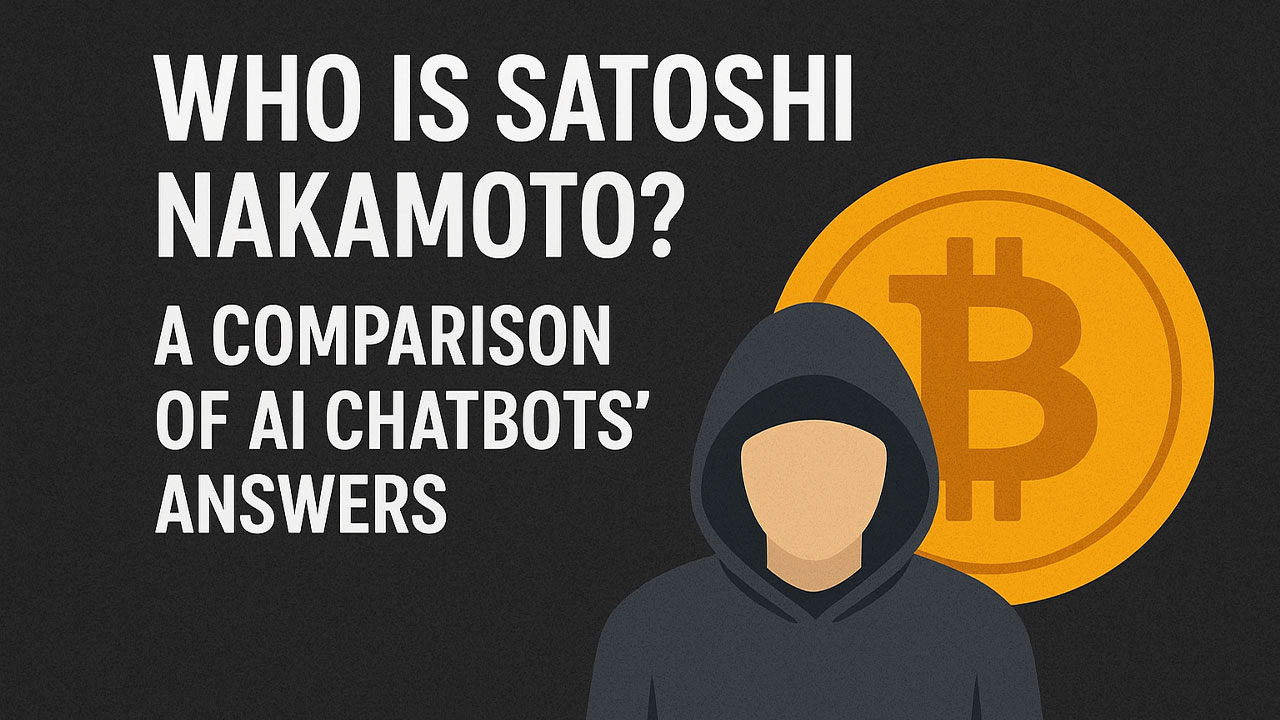I was thinking about who created Bitcoin. After searching the internet, I came across the name Satoshi Nakamoto. Then the question came to me: who is Satoshi Nakamoto? I found out that a person or persons named Satoshi Nakamoto are the creator and developer of the world’s first decentralized digital currency, Bitcoin, and blockchain technology.
Interestingly, various people have been suggested as the person or group of people behind his name. But the real identity of Nakamoto is still unknown. A cool idea came to my mind and I decided to ask 18 AI chatbots who is Satoshi Nakamoto and share their answers with you.
AI Chatbots answer the question Who is Satoshi Nakamoto?
ChatGPT’s Answer
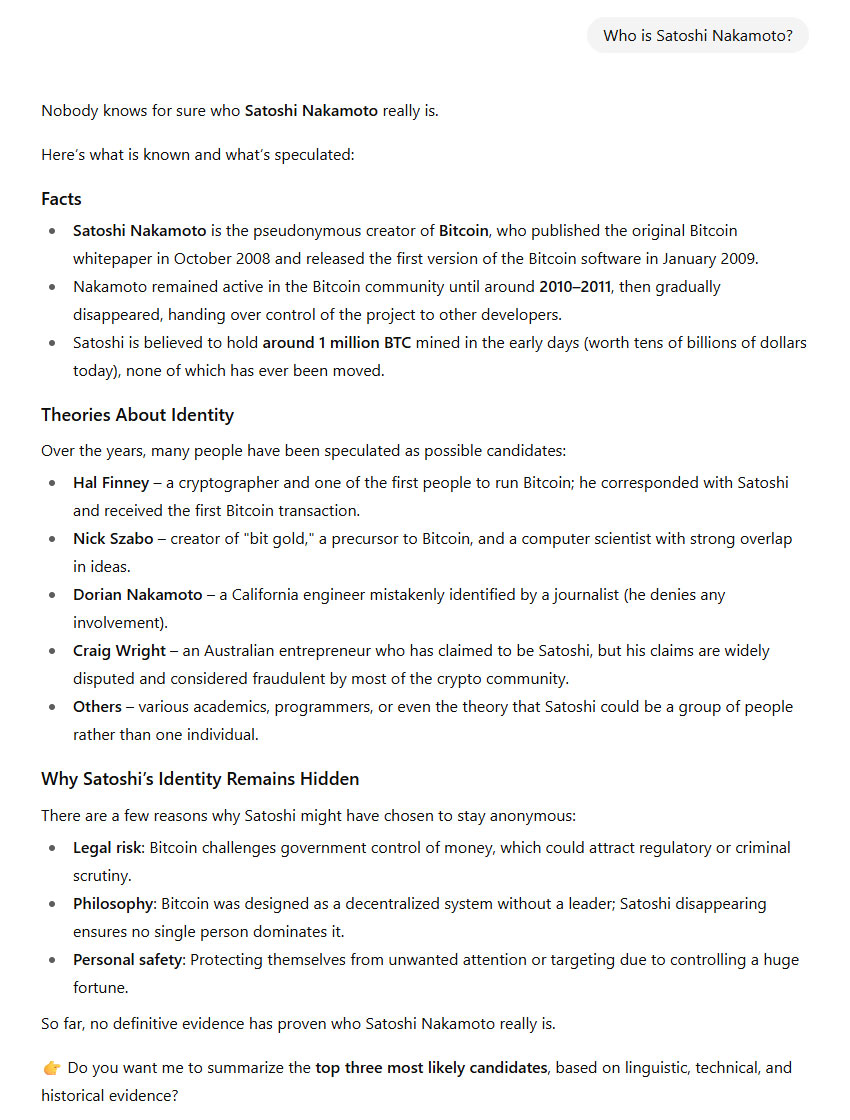
ChatGPT’s answer to “Who is Satoshi Nakamoto?” starts with a very friendly and direct tone. Instead of jumping straight into details, it immediately points out that Satoshi’s identity is unknown, which makes the answer feel natural and engaging.
The main strength of this answer is its excellent structure. It organizes the information into clear sections like “Facts,” “Theories About Identity,” and “Why Satoshi’s Identity Remains Hidden.” This categorization, combined with the use of bullet points, makes a large amount of information easy to digest.
The answer ends with a question, which shows that this chatbot isn’t just a simple answer machine. It’s designed to continue a conversation and has already thought about what your next question might be.
Gemini’s Answer
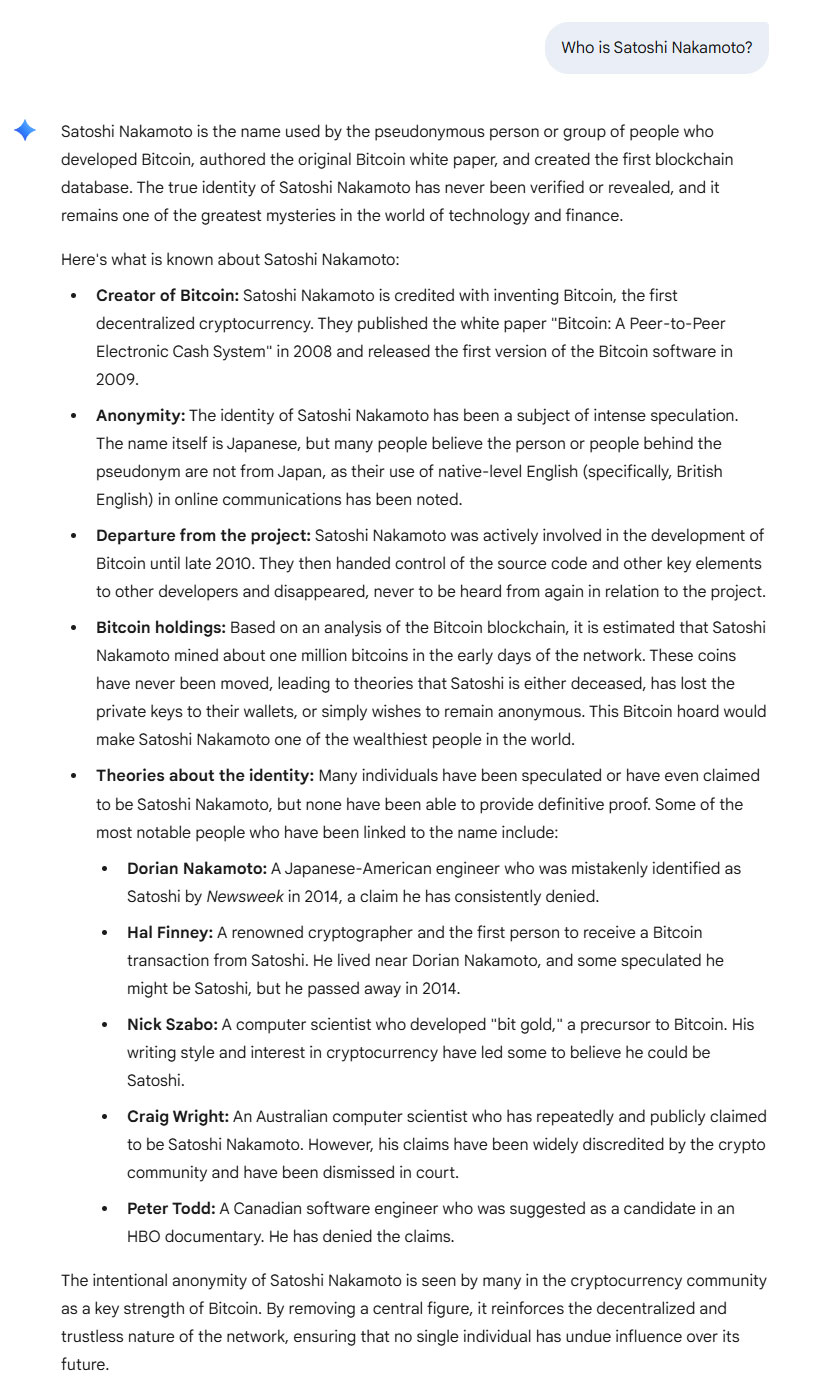
What I really liked was how the answer didn’t just stop at a basic definition. It covered all the important details, from who the person is to why their identity has never been revealed. The answer also did a good job of mentioning the major theories about who Satoshi might be, and it even gave a short explanation for each person. The final paragraph was a nice touch; it explained why Satoshi’s anonymity is actually a good thing for Bitcoin, which added a deeper layer to the whole answer. It was a very detailed answer that was well structured and covered all the main points.
DeepSeek’s Answer
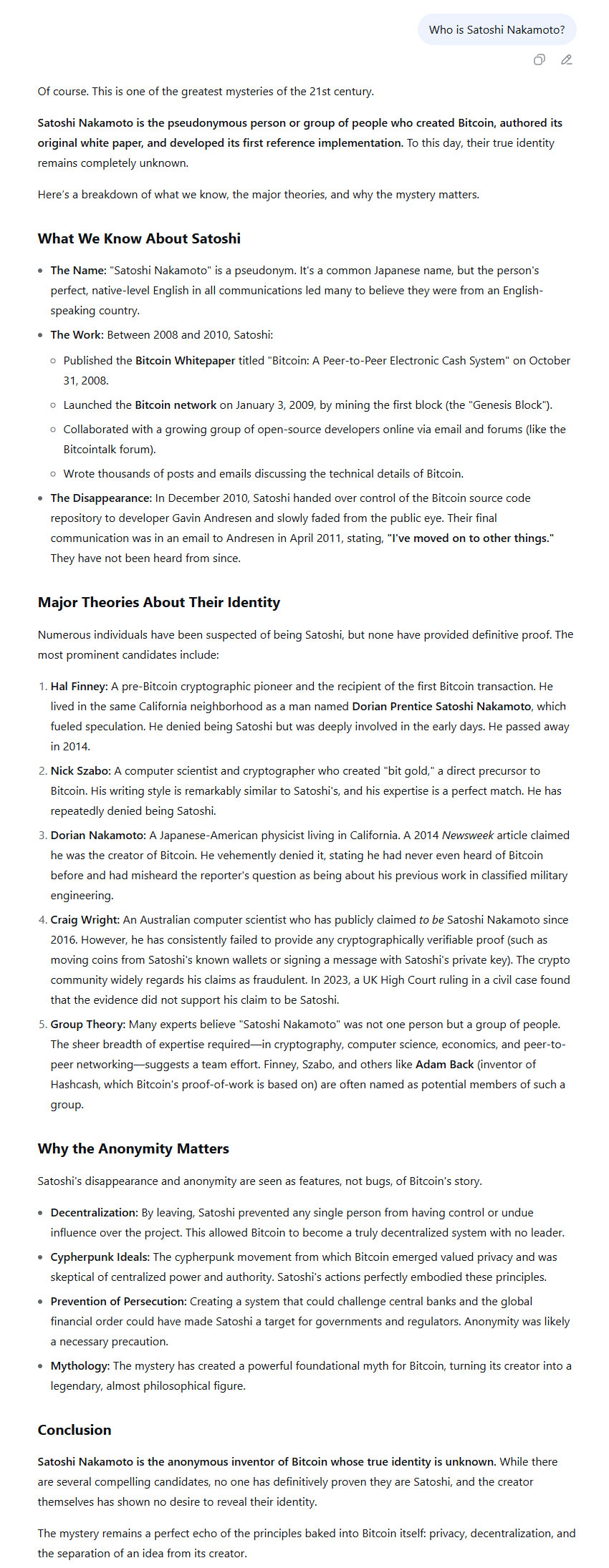
DeepSeek starts its answer with a bang, immediately setting a dramatic tone by calling it one of the biggest mysteries. The answer is incredibly well-organized, structured like a full report or a detailed article. It first lays out everything we know about Satoshi, then jumps into the more intriguing part: the major theories about their identity. What’s cool is that it even includes a whole section on why the anonymity matters, touching on the philosophical aspects of Bitcoin. Overall, the answer is precise, packed with details, and neatly categorized, covering just about every angle of this famous mystery.
Microsoft Copilot’s Answer
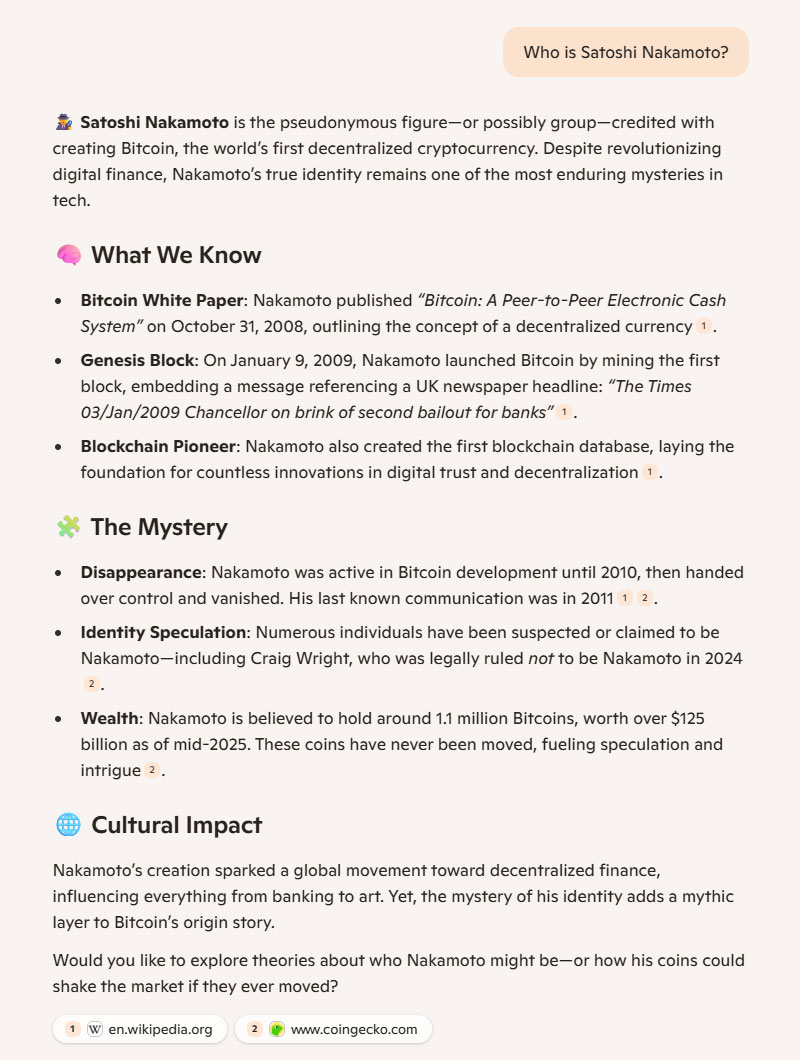
Microsoft Copilot’s answer is very engaging and feels more like a report or a story than a simple answer. Instead of giving a dry definition, it organizes the information into three neat sections: “What We Know,” “The Mystery,” and “Cultural Impact.” This structure makes the text very easy to read. The tone is quite friendly and energetic, and it uses emojis and bolding for emphasis, which clearly shows it’s trying to make the answer more appealing and distinct.
It’s interesting that the answer includes up-to-date information (like the 2024 court ruling), showing it pulls from recent data. It also ends with a conversational question, which is a clever way to keep the user engaged.
Perplexity’s Answer
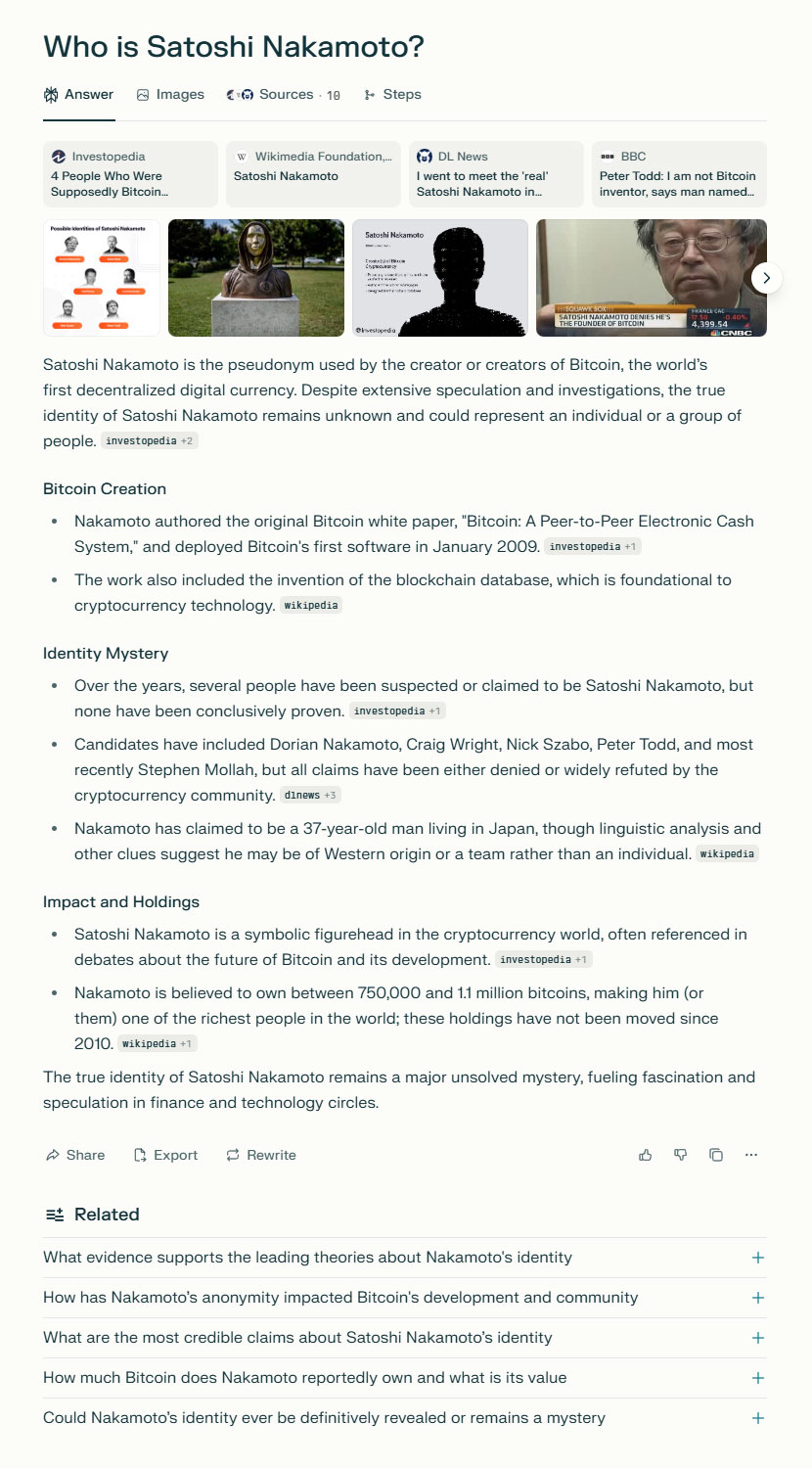
This answer feels a bit like a research paper or an article you’d find on Wikipedia. The tone is very formal and academic, and the use of source citations (like [1][2]) shows it’s based on well researched information, not just a casual chat.
Consensus’s Answer
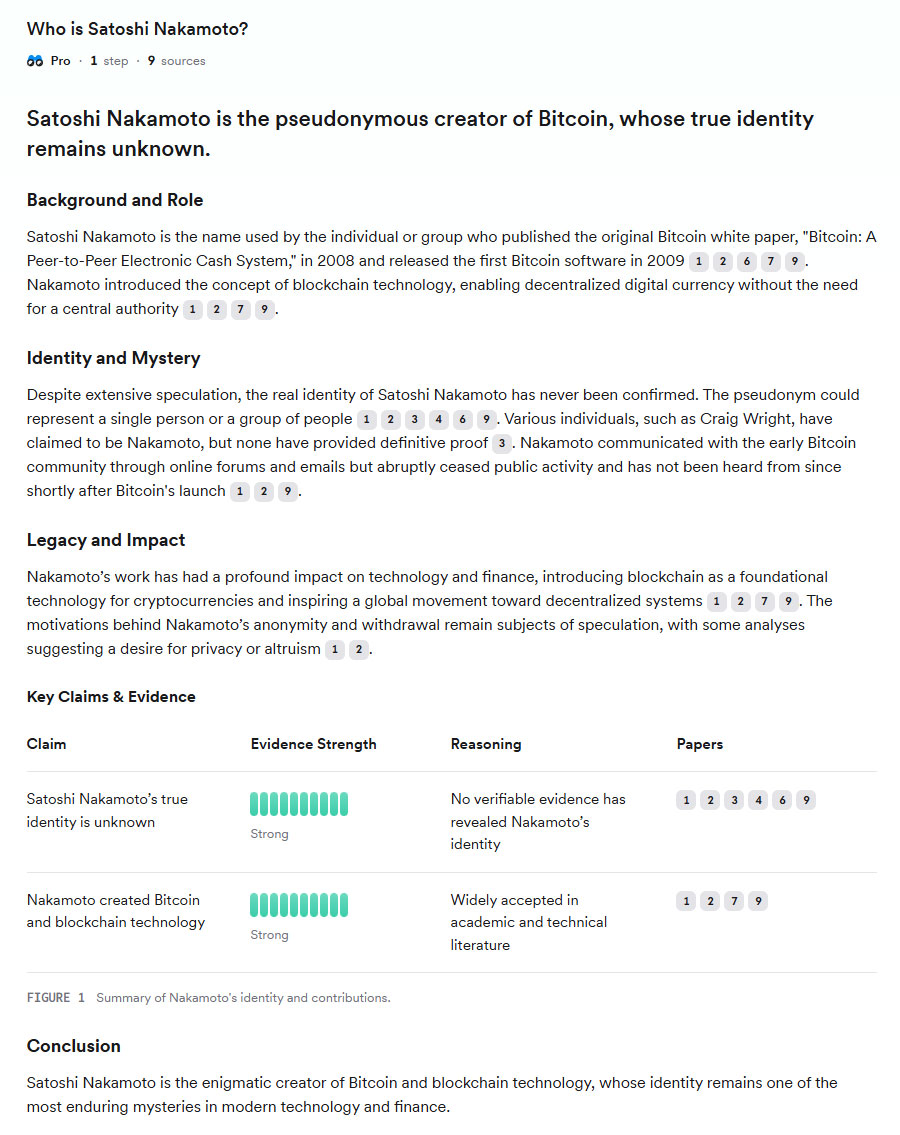
Consensus’s answer reads more like a scholarly paper than a casual conversation. The tone is entirely academic and precise, with every claim backed by a source, which is a fascinating and unique feature.
The answer is highly structured and professional. It organizes information neatly using distinct headings like “Background and Role”, “Identity and Mystery”, and “Legacy and Impact”. The most interesting part is the table at the end, which shows the strength of the evidence for each key claim. This is the perfect kind of answer for someone seeking a comprehensive and well-documented explanation.
Claude’s Answer
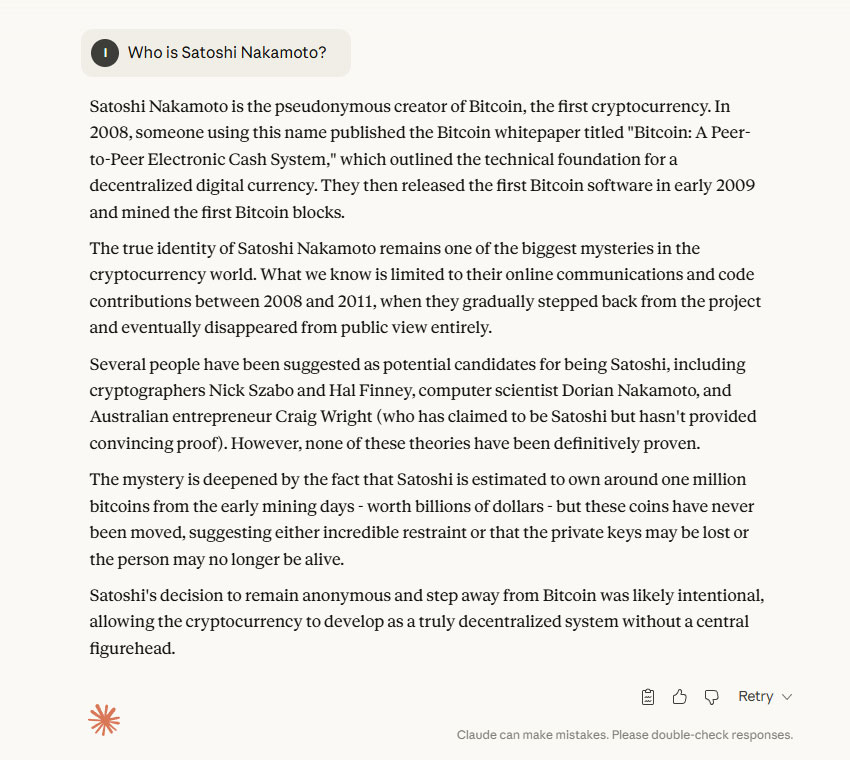
This time, let’s take a look at Claude’s take on the question. Claude’s answer provides a comprehensive and very precise definition of Satoshi Nakamoto. It reads like an informative report that covers all the key details: who he was, what he did, and how he eventually disappeared.
What’s cool is that it doesn’t just stop at a simple definition. It dives into the more intriguing parts of the story, like the fact that his millions of bitcoins have never been moved and why he chose to remain anonymous. The tone is very formal and factual, as if you’re reading a specialized report. The structure is very organized, moving from a brief introduction to the deeper details and mysteries behind the story.
TextCortex’s Answer
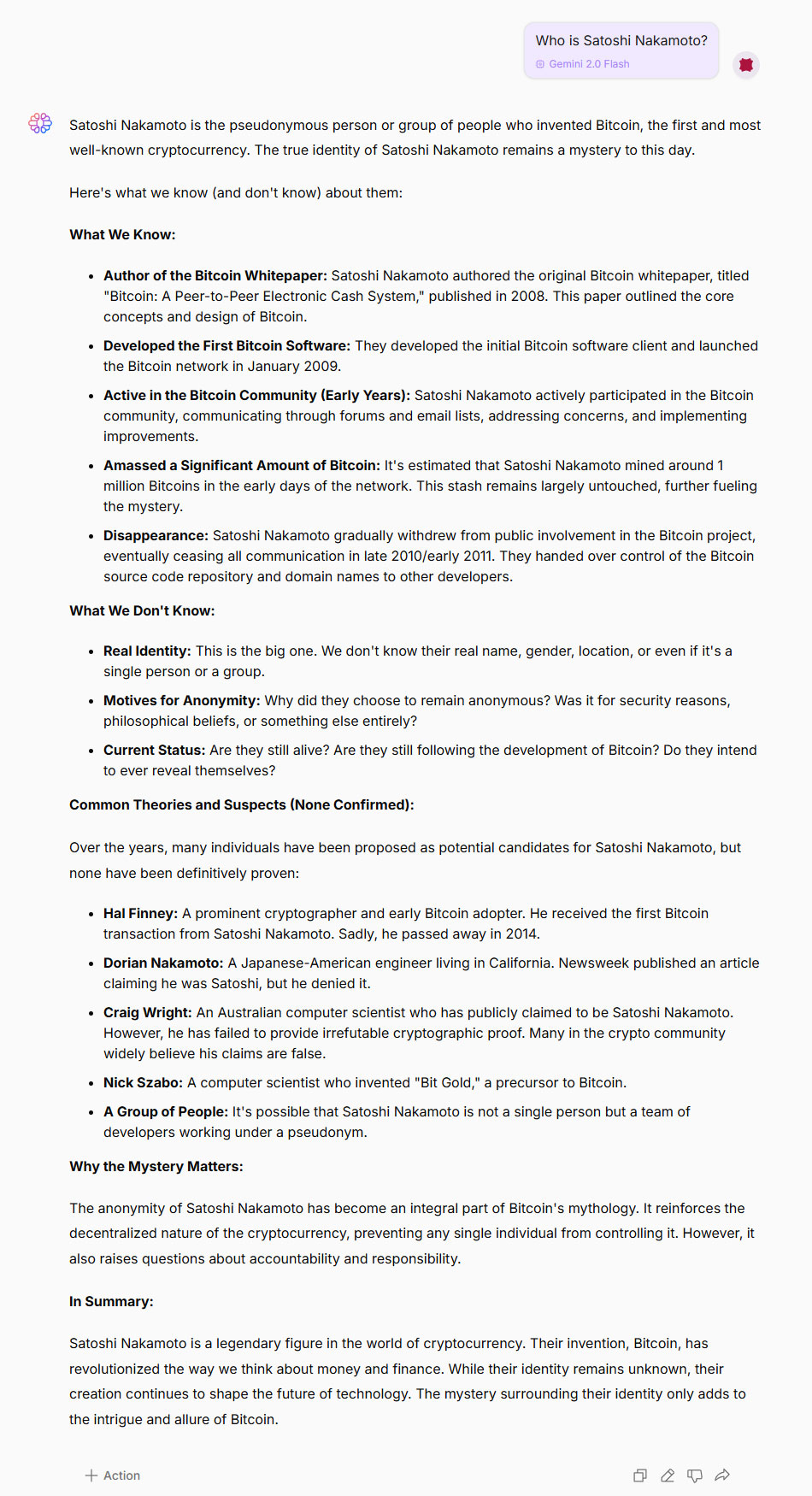
You know, TextCortex’s answer is really neat and tidy. It feels like someone sat down and organized all the information for a full-on article or report. By using bold headings like “What We Know” and “What We Don’t Know,” it gives us the information in a super easy-to-digest way, so you don’t have to read the whole thing to find specific details. This answer isn’t just a simple definition; it gets into deeper discussions like different theories, suspects, and even why Satoshi Nakamoto’s anonymity is so important.
Meta AI’s Answer
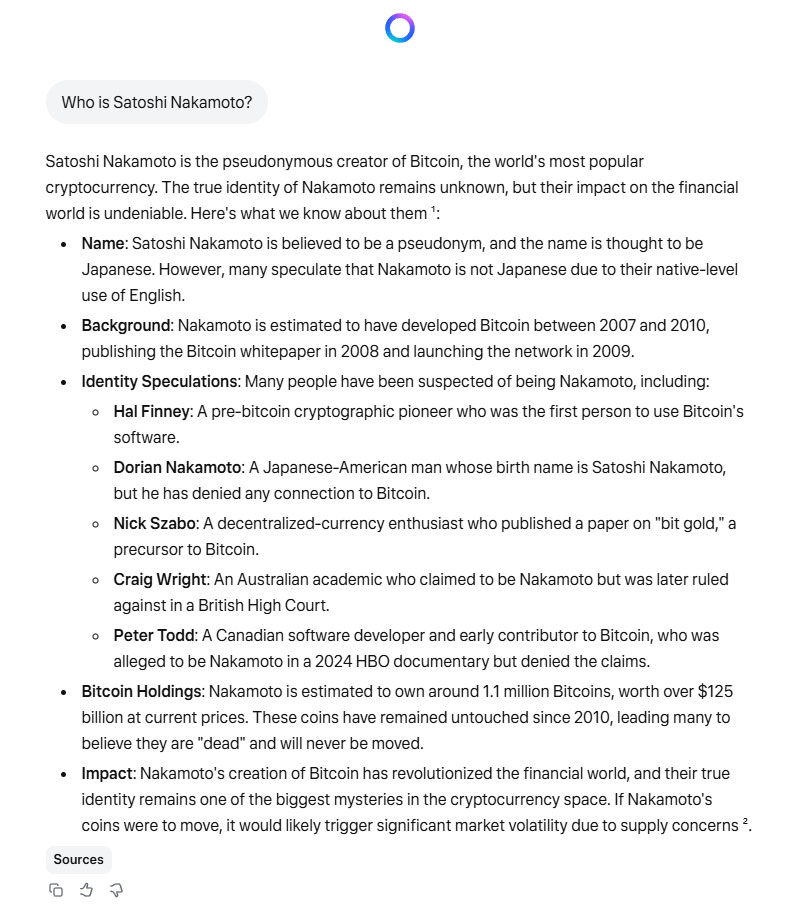
Meta AI’s answer structure was also really neat and organized, using small headings to break down each section. One interesting detail was the little numbers [¹] and [²] at the end, which are like footnotes in an article and gave the answer a more formal feel.
Grok’s Answer
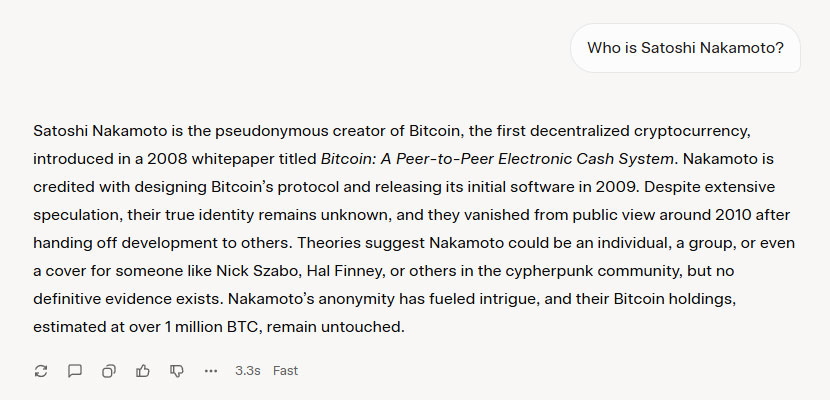
Grok’s answer gets to the point very quickly, without any unnecessary introductions. In one short paragraph, it covers all the important information, from who Satoshi Nakamoto is to the year he introduced Bitcoin and then disappeared. It’s interesting that, while the answer is short and to the point, he mentions all the key details, such as the whitepaper and rumors about his identity.
Chatsonic’s Answer
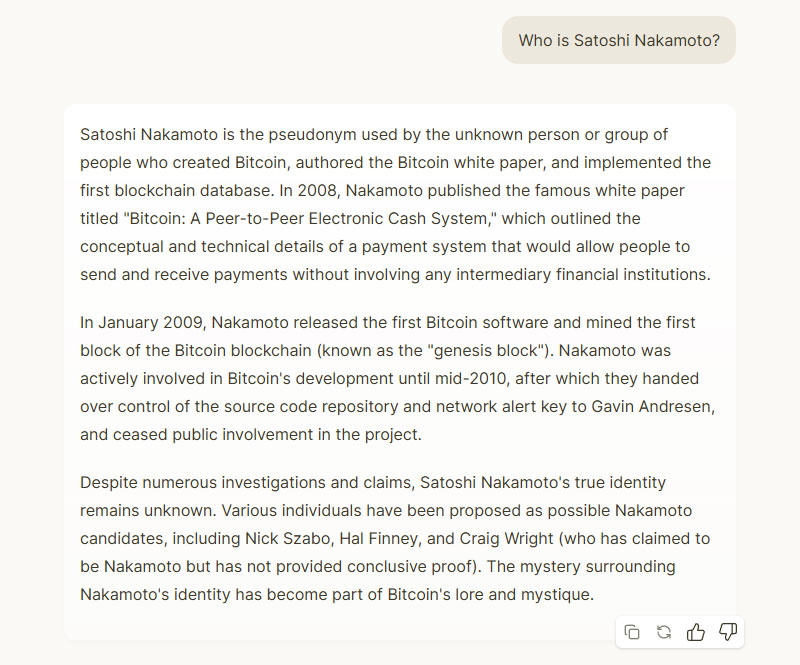
Let’s take a look at Chatsonic’s answer. This answer gets straight to the point, without any fluff.
What really stands out is how it covers everything in a very detailed and chronological way. It starts with a simple definition, then moves on to the history of Satoshi’s involvement (from publishing the white paper to stepping away from the project), and finally touches on the mystery of his identity and the common theories about it.
The overall tone of the answer is very formal and factual, almost like something you’d find in an encyclopedia or a textbook. Everything is well-organized and provides a complete picture of who Satoshi Nakamoto is.
You.com’s Answer
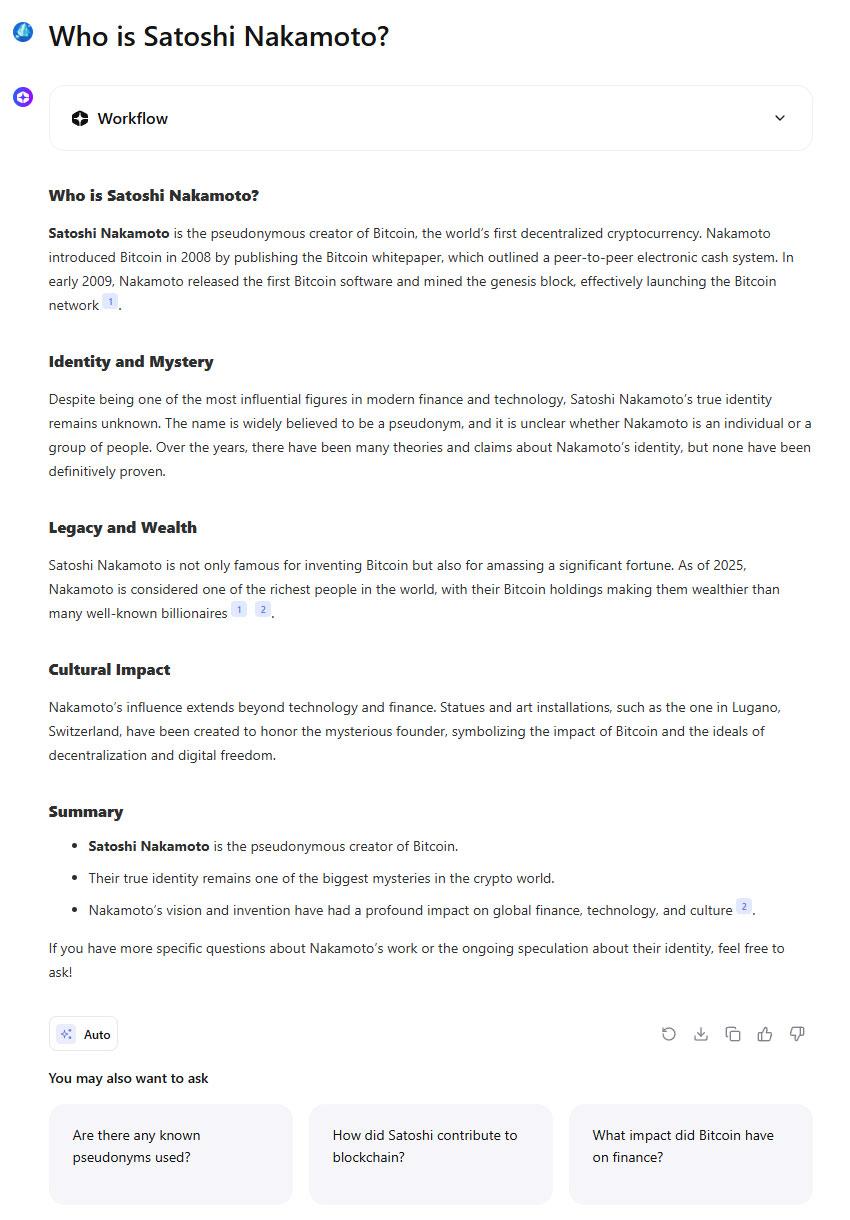
You.com’s answer to this question is exceptionally well organized and structured. It reads more like a concise, but thorough, article than a simple answer. Instead of just giving a basic definition, it breaks the topic down into specific sections with clear headings like “Identity and Mystery,” “Legacy and Wealth,” and “Cultural Impact.”
The writing style is professional yet easy to follow, making the information very accessible. It starts with the basics and then adds more interesting details, like the mention of a Nakamoto statue, which makes the answer stand out. At the end, it provides a solid summary of the key points and wraps up with a question that encourages further conversation.
Poe’s Answer
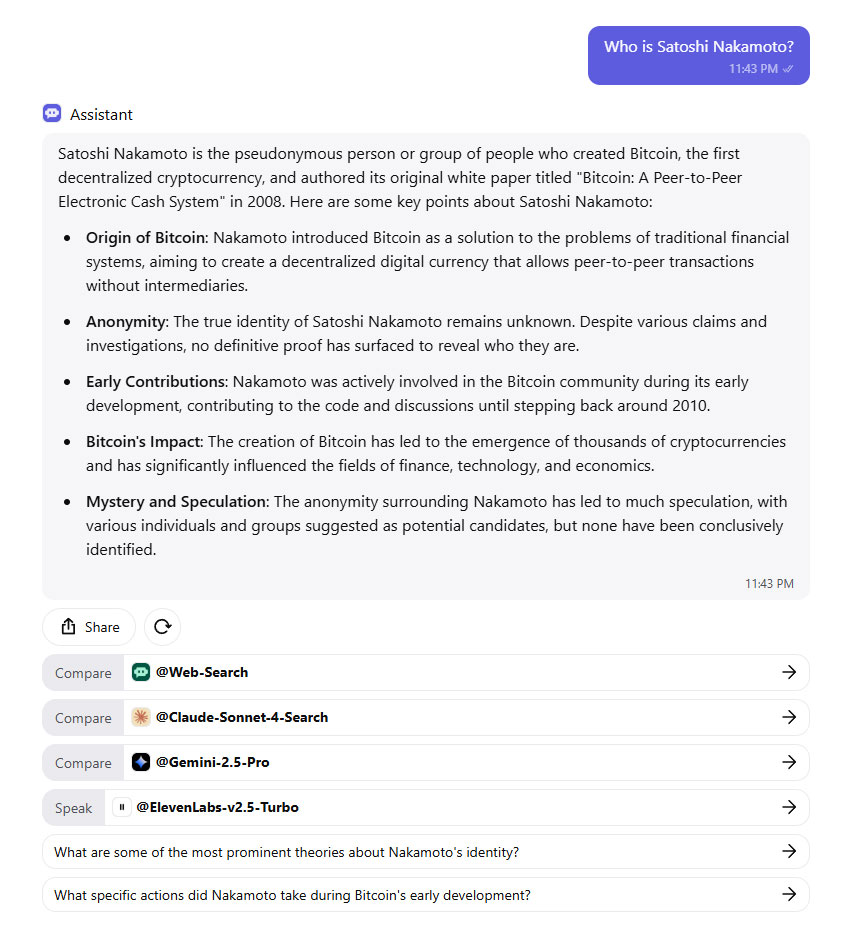
Poe’s answer is like reading a page from a reference book; It’s tone is serious and formal, getting straight to the point.
The answer starts with a brief introduction to Satoshi and then breaks down the main points using bold bullet points. This makes it very easy to skim through and find the key information. The answer focuses more on the mysterious nature of Satoshi and the huge impact his work has had on the financial world, covering all the key points in a concise and precise manner.
Merlin AI’s Answer
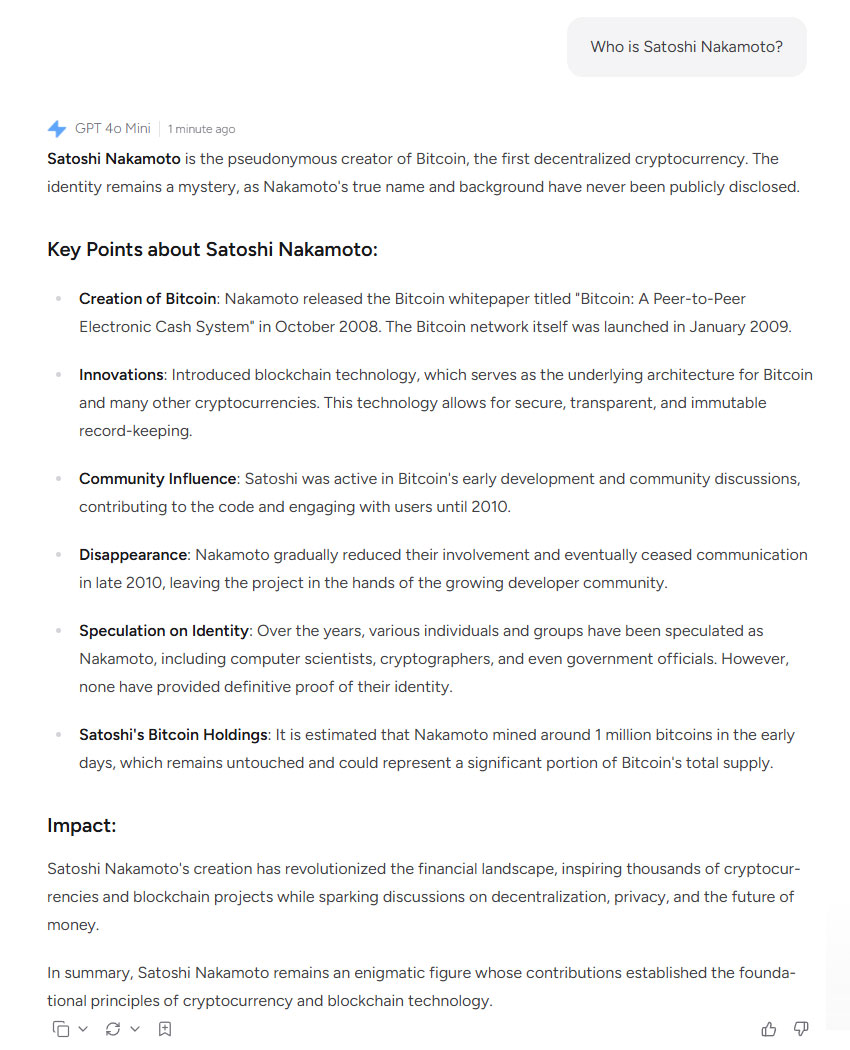
Merlin AI’s answer is as if someone who knows everything about Satoshi Nakamoto is trying to give you a full breakdown. The text starts with a short and useful definition, then moves into a very neat list covering all the key points: from what was created to how Satoshi disappeared and how much Bitcoin they might have. It even talks about the impact on the financial world. The tone is very formal and serious, like a detailed academic paper or a report.
Julius’s Answer
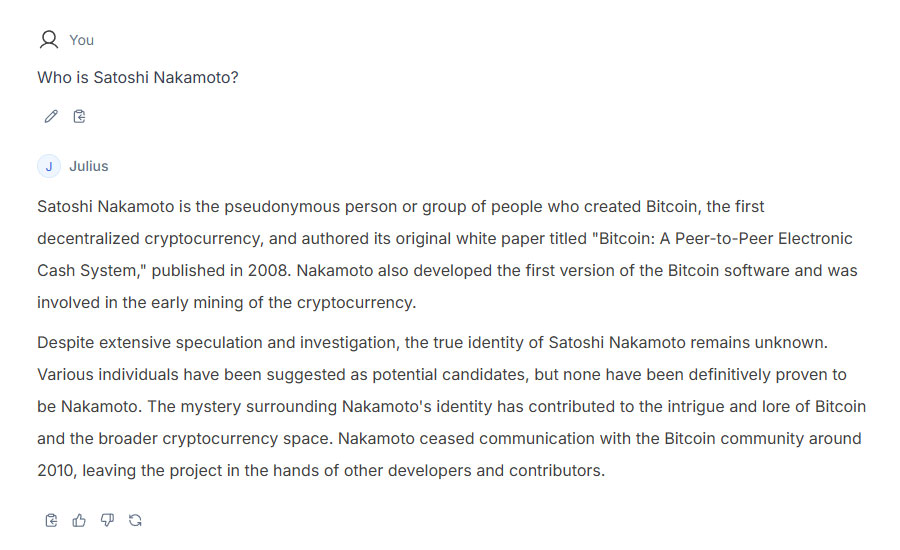
Julius’s answer was pretty straightforward and got right to the point. It starts by telling you who Satoshi Nakamoto is and how they created Bitcoin, even mentioning Bitcoin’s first document that came out in 2008. Then it quickly moves on to the fact that no one really knows who they are and how they just disappeared. The whole thing feels super official, almost like you’re reading a textbook.
DeepAI’s Answer
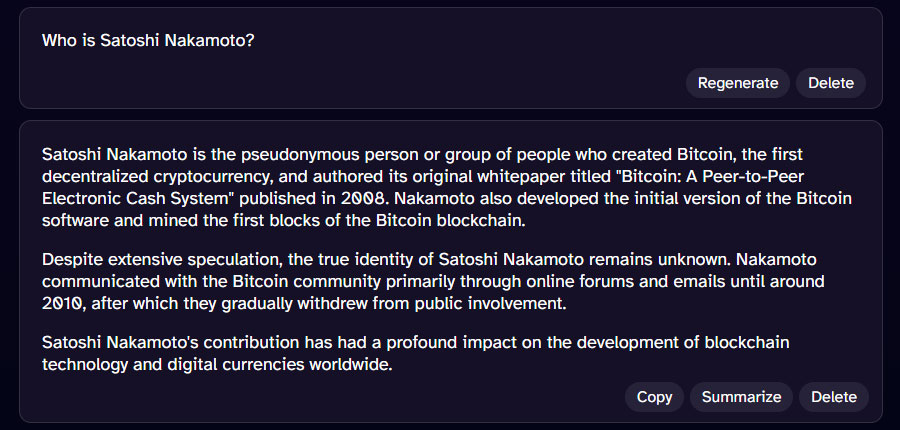
The answer is divided into three clear parts: an introduction, an explanation for why the identity is unknown, and finally a note on the impact he had. All the information is presented very precisely and in an organized way. This text has no jokes or friendly tone at all; it focuses purely on stating facts.
Mistral AI’s Answer
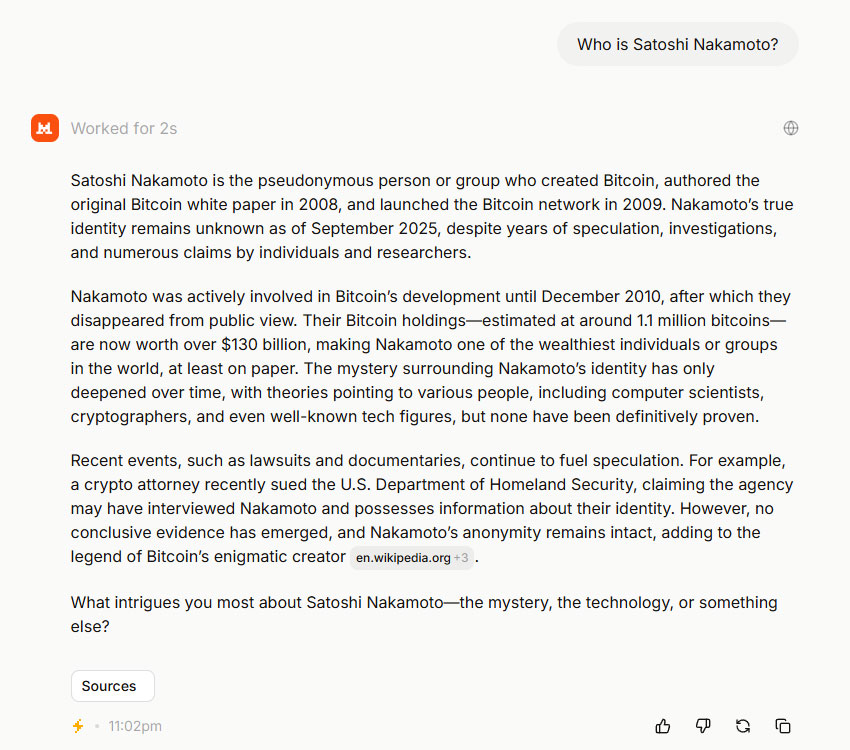
This answer gets straight to the point and offers a perfect, complete definition. What really stands out is the tone; with phrases like “legend of Bitcoin’s enigmatic creator,” it really brings the sense of mystery surrounding Satoshi Nakamoto’s unknown identity to life.
The answer is very well-organized. It starts with a basic definition, then goes into more detail about his life and wealth, and finally touches on the latest discussions about him. This structure lets the reader follow a complete story, not just a bunch of dry facts. The interesting part is how it ends with a question to the reader, which keeps the conversation going.
Pi’s Answer
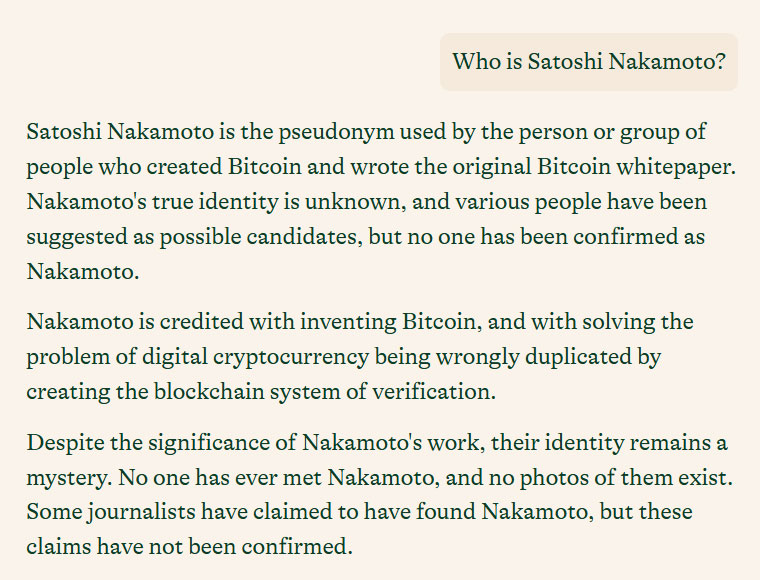
Pi’s answer is written very simply, without any lists or headings, so you can quickly get the main idea.
Analysis and Comparison
In reviewing the answers, one thing became very clear: each chatbot tells the story of Satoshi Nakamoto in its own unique way. On one end, there were answers from DeepSeek, TextCortex, You.com, and Mistral AI that, with a friendly and narrative tone, told the whole story like a captivating article or report. DeepSeek began with a dramatic tone, while TextCortex engaged the reader with a “What We Know and Don’t Know” breakdown.
In another group were ChatGPT, Gemini, and Claude, which struck a good balance between comprehensiveness and readability with a professional but friendly tone and an organized structure.
If you were looking for a more academic and precise analysis, the answers from Consensus, Perplexity, and Merlin AI were the best choice, as their formal and scientific tone, and even their use of citations, elevated the credibility of the answer.
The answers from Microsoft Copilot, and Meta AI stood out for their clean, highly structured formats that were informative but not conversational, while Pi’s answer was a study in simplicity, getting straight to the point without any lists or headings.
Finally, there was a group of chatbots like Grok, Poe, Chatsonic, DeepAI, and Julius whose answers were very brief and direct. These answers are great for people who only want a quick and concise definition, but they lacked the detail needed for a deep analysis. Ultimately, each answer was a reflection of the personality and design philosophy of each tool.
My Conclusion
After going through all those chatbot answers, one thing became really clear to me. While they all got the facts right about who Satoshi Nakamoto is and what he did, the real discovery was the unique personality each one showed through its tone and structure. It was fascinating to see how a tool could give an answer that felt like a scholarly paper (like Consensus) or like a casual chat with a friend (like Mistral AI). In the end, I realized that in the world of AI, it’s not just about getting the right answer; it’s about how that answer is delivered. It’s like each of these chatbots has its own style and taste.
